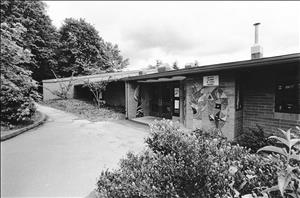This history of Dearborn Park Elementary School is taken from the second edition of Building for Learning: Seattle Public School Histories, which includes histories of every school building used by the district since its formation around 1862. The original essay was written for the 2002 first edition by Nile Thompson and Carolyn J. Marr, and updated for the 2024 edition by HistoryLink editor Nick Rousso.
Beacon Hill
In the late 1950s, the Seattle School Board realized there was very little undeveloped land remaining in the Beacon Hill area. One vacant site was adjacent to the City of Seattle’s Dearborn Park, and the board decided to purchase it for a future school. It took about 20 years for the school to become a reality. Neighborhood activists helped bring attention to the "unbuilt school" they wanted for their children. The closure of Georgetown in 1970 and overcrowded conditions at nearby schools forced the board to act.
Principal Robert Middleton and seven teachers from Georgetown had the unusual opportunity of working with the architects in de- signing the new open-concept school. The building was divided into large teaching areas called pods for use by topical groupings of children from various grades. Dearborn Park Elementary was named for the park that adjoined the school grounds.
Students from overcrowded Van Asselt, Brighton, and Columbia were assigned to the new school and placed in separate classrooms at those schools while awaiting the opening of Dearborn Park. The school opened in spring 1971 with about 500 students. The student body quickly exceeded the capacity of the building, and portables were added behind the gymnasium. At first, 3rd through 6th graders rotated classes like middle and high schoolers, but this system was abandoned after several months. The school staff’s philosophy was, "The tie that binds us is the child and we are here to help him realize the fullness of his potential." About 25 percent of the students were transported to the school by bus from the Rainier Vista Housing Project area. Under the district’s desegregation plan, Dearborn Park held grades 4-6 and was paired with Magnolia (K, 1-3) from 1978 until 1984. After Magnolia closed in June 1984, Dearborn Park was paired with Lawton.
In 2001, Seattle voters approved a $398 million, six-year capital levy. Some of the funds were earmarked to remove portables at Dearborn Park and replace them with permanent structures. A subsequent capital-budget deficit in 2005 deferred those renovations indefinitely. Enrollment was less than 300 and the school board weighed a proposal that would have closed Dearborn Park along with six other smaller schools in the district. Dearborn Park was not closed, and in 2006 the portables were removed. The existing building was expanded to include four new classrooms, a cafeteria/auditorium, and a gymnasium, increasing K-5 capacity to 450.
The City Light power line right-of-way that bisects the site and other natural features of the site placed constraints on site usage. One solution was to construct a small building that houses the childcare center and a special-use classroom on the west side of the main building. Since there is not enough space for a play structure, the district leased a portion of the City Light right-of-way for the playground and the school’s driveway. In 2007, students from Whitworth were merged with Dearborn Park students when Whitworth closed.
The remodeled Dearborn Park also includes a state-of-the-art library, partially funded by private donations. Dearborn Park was one of 32 elementary schools nationwide to receive money from Target and The Heart of America Foundation for library improvements. When it was unveiled on September 7, 2012, the new library featured 2,000 new books; new furniture, carpeting, and storage; and a complete technology upgrade including iPads. Each student received seven new books to take home.
Outdoor Education
Dearborn Park has been at the forefront of environmental education since the mid-1990s. The school’s property includes six acres with woods and wetlands, into which trails were cleared and gardens were installed. An international garden with herbs and vegetables from the many cultures of students was planted. A 2.6-acre tract adjacent to the school was developed by students and staff, along with Seattle Parks and Recreation, the Trust for Public Lands, EarthCorps, and other groups. This space is used for environmental education for Dearborn Park and other Beacon Hill schools.
In 2013, Dearborn Park became a focal point for pedestrian safety when Seattle Mayor Mike McGinn announced a plan to install sidewalks, amber warning lights, curb bulbs, and speed-enforcement cameras near more than 20 schools in the district. According to The Seattle Times, while McGinn spoke outside Dearborn Park, cars zipped by on South Orcas Street at close to 40 mph. "Dearborn Park is in the forefront," wrote the Times. "New sidewalks were built on one side of South Orcas Street recently, and speed cameras are proposed next year. On Wednesdays, Principal Angela Bogan and parents lead a ‘walking school bus,’ in which children arrive together from four directions."
In the fall of 2014, Dearborn Park became Seattle Public Schools’ eighth school with a language-immersion program, and the school was renamed Dearborn Park International School to reflect the change. Language immersion began with kindergarten and built up with each incoming kindergarten class. As of 2021, the school was offering immersion programs in Spanish and Mandarin.
History
Dearborn Park Elementary School
Location: 2820 S Orcas Street
Building: Brick
Architect: Fred Bassetti & Company
Site: 10.3 acres
1971: Opened in spring
2006: Portables removed
2007: Gym/cafeteria addition, Childcare and art room constructed (Mahlum Architects)
2007: Merged with Whitworth Elementary
2014: Renamed Dearborn Park International Elementary School
Dearborn Park International Elementary in 2023
Enrollment: 321
Address: 2820 S Orcas Street
Nickname: Dragons
Configuration: K-5
Colors: Navy blue and white

